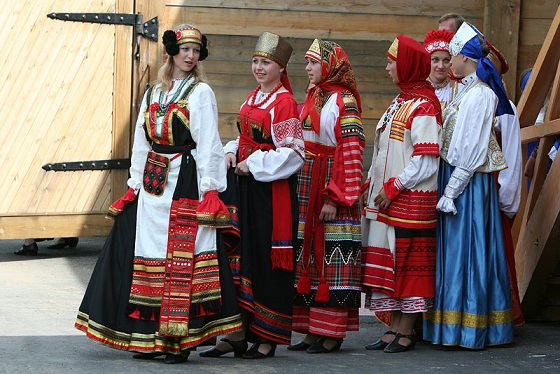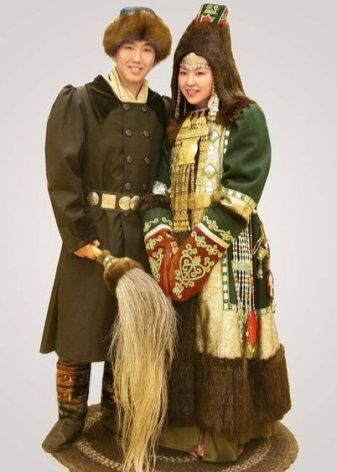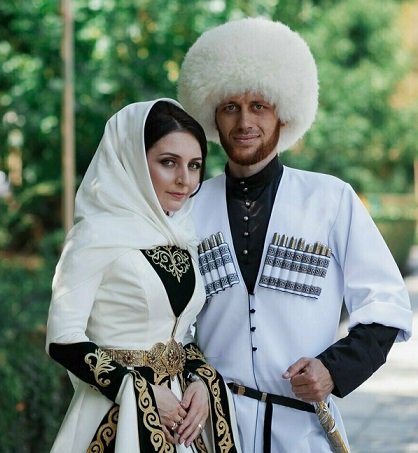
Being a multinational country, Russia boasts a richness and a huge
variety of cultures. Hundreds of peoples of various sizes live in the
expanses stretching from the Caucasus Mountains to the northern
permafrost, with their own special way of life, culture, and unique
traditions. These differences between them are explained by geographical
and historical features, religion, the climate of the region and many
other factors. These features are manifested in various cultural
heritage, including the national costumes of the peoples of Russia.
Vintage things do not go out of fashion even today. Although in our
time it is rare to meet a person walking down the street in the national
costume of his people, yet every resident should remember them and know
how they look.
However, there are those who use one element from
an old outfit in their fashionable look - this is stylish, gives some
zest and originality.
Those things that our grandmothers and
great-grandmothers wore can already be called antiques, and many simply
store them in chests or wardrobes. The national costumes of different
peoples of Russia are distinguished by a wide variety of fabrics,
accessories, colors, patterns, as well as sewing methods. In different
parts of our vast country, they wore completely different national
outfits. Each of the costumes is different from each other, but at the
same time they are all special for their people.
B
Bashkir National Costume
C
Chuvash national costume
Cossack clothes
Y
Yakut National Costume
I
Ingush National Costume
K
Kalmyk National Costume
M
Mari National Costume
Mordovian National Costume
R
Russian national costume
T
Tatar costume
U
Udmurt
national costume
X
Khakass clothes
RUSSIAN

Let's start with the national costume of the most numerous people of
Russia. The historical basis of the wardrobe of every Russian man or
woman was a shirt, which, depending on the gender, could be worn on top,
a caftan or a sundress.
Finishing and material of different items
of clothing differed. So, a festive outfit is characterized by an
abundance of embroidery. Her main motif was various folk patterns, each
of which has its own meaning. No restrictions were adopted, so the
embroidery was a kind of "calling card" of the owner, which told his
story.
Also, by clothing, it was easy to determine which class a
particular person belongs to (for example, embroidery with gold and
silver thread was popular among the rich population) or what his marital
status was (for example, only married women could wear such a headdress
as kichka women).
Another feature of the national Russian costume
is its layering. This is due to the rather changeable weather in most
regions, as well as cold weather, so a caftan and a quilted jacket were
an integral part of every person's wardrobe.
Russian national
clothes combined beauty and functionality. It must be free, not squeeze
anything, but at the same time, both women and men wore belts. The
richer versions worn by the boyars were decorated with furs.
Features of national Russian clothes:
The outfit was multi-layered,
which was especially true for women. A poneva was put on the shirt, and
on top was a “zapon” or an apron, and then an apron.
All clothing was
mostly loose-fitting. For convenience and freedom of movement, it could
be supplemented with rectangular or oblique inserts.
All models had a
common obligatory element - a belt. This detail was used not only to
decorate or hold clothes. The ornaments on the belts also acted as a
talisman.
All clothes, including everyday and work clothes, were
decorated with embroidery. It carried a special sacred meaning for our
ancestors and acted as a protection against evil spirits. You can learn
a lot about a person from embroidery.
Russian folk costumes were made
from bright fabrics and richly decorated with braid, beads, embroidery,
sequins, and patterned inserts.
A mandatory element of both men's and
women's clothing was a headdress. In some areas, in married women, it
was multi-layered and weighed about 5 kg.
Each person had special
clothes for rituals, which were more richly embroidered. They tried not
to wash it, so as not to spoil it, and put it on only a few times a
year.
TATAR

The Tatar national costume is an extremely interesting combination of
two trends at once: it was influenced by the common traditions of the
Eastern peoples and Islam at the same time. The basis is a shirt-dress,
which is called "kulmek", and bloomers.
Other components of the
Tatar wardrobe were beshmet, chekmen and kazakin - these are several
types of outerwear. Also, a dressing gown was often worn on top,
initially considered the subject of a predominantly working wardrobe.
Among the female population, vests and aprons, scarves (as an obligatory
component of the Muslim wardrobe) and large jewelry were also popular as
an accessory. And the national men's headdress - skullcap - is still
worn by some representatives of the people for religious ceremonies or
even in everyday life.
BASHKIR

The Bashkir costume, like the clothes of many other peoples of
Russia, was made according to one pattern for men and women. A
distinctive feature is that the Bashkirs used not only vegetable fibers,
traditional for that time, but also leather and fur as the main
material. Yelyan and kazakin, deaf suits lined with long sleeves, were
primarily common among this people as outerwear.
An important
component of any festive clothing was a robe or fur coat (depending on
the time of year). The robes were richly embroidered with jewelry,
bright embroidery, and stones. For women, the festive set also included
a dress and an apron with embroidered patterns.
YAKUT

The Yakuts are historically located in the north of Russian
territory, so their national costume was designed not only to decorate,
but also to reliably protect from the effects of very low temperatures.
The uniqueness of the Yakut national costume lies in the fact that it is
alive and continues historical traditions even today among the modern
population of the region. The Yakut clothing culture combines many
diverse elements.
Outerwear is extremely dense, made of fur,
leather, cloth and other materials. Traditionally, the wardrobe is
embroidered with beads, ornaments, metal, various pendants. Such decor
is always bright: even everyday sets look quite elegant. The difference
between the festive version is in a much more complex style.
DAGESTAN

Another national costume of the peoples of Russia, which we will
consider, is Dagestan - it is one of the most striking and
characteristic in the North Caucasian culture. It was created under the
influence of two factors: the Muslim tradition and the mountain climate.
Elements of the Dagestan costume quite often underwent numerous changes,
but the basis remained unchanged.
For men, the classic set is a
white shirt, black trousers and a Circassian coat (caftan), usually red.
The costume was completed by a thin belt, on which weapons, boots, and
also a headdress - a fur hat were attached. Dagestan women dressed
strictly according to the Muslim tradition - in a dress that completely
covered the body and a scarf. Such clothes are most often made of silk
and are distinguished by a variety of shades.
Of course, there
are dozens of other peoples of Russia with their unique bright costumes
that amaze with their beauty and originality. However, in all of them
there are common elements by which it can be understood that they belong
precisely to the people from Russia.